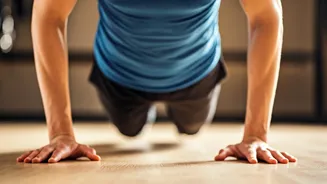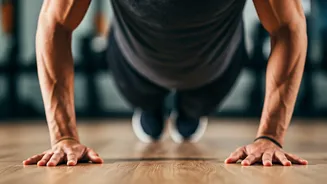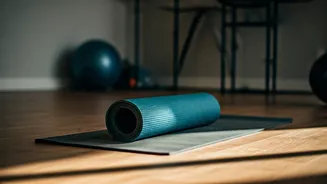Quality Over Quantity
One of the most frequent errors people make when doing push-ups is prioritizing the number of repetitions over the quality of each movement. Fitness and
Pilates expert, Dr. Vajalla Shravani, highlights that rushing to increase reps without a strong foundation or correct form often leads to poor form, such as hip sagging, elbow flaring, or incomplete range of motion. These compensations not only reduce the exercise's effectiveness but also increase the risk of injuries. To improve safely, Shravani suggests breaking down push-ups into different stages to gradually build strength.
Push-Up Progressions
To embark on your push-up journey safely and effectively, Garima Goyal, a fitness expert, suggests a structured approach. Start with incline push-ups, placing your hands on an elevated surface like a bench or step. This reduces the amount of weight you’re pushing, helping to build strength progressively. Once you're comfortable, move to incline knee push-ups. Progress to standard knee push-ups before attempting the full push-up. Focus on proper form: maintain a plank position with hands slightly wider than shoulder-width, engage your core by drawing your navel towards your spine, and inhale as you lower yourself, exhaling as you push back up. Keep your elbows close to your body and lower your chest until it nearly touches the ground. Look at a point on the floor to maintain a neutral head position. Control your movements.
Muscle Engagement Matters
Push-ups are an all-encompassing exercise that targets the upper body, core, and glutes. These movements engage the chest, shoulders, biceps, and triceps, making it a form of calisthenics that uses your body weight to increase upper body strength. The key is to concentrate on engaging the muscles throughout the entire movement. Ensure that you're controlling the lowering and raising phases and avoiding jerky motions. The goal is to move smoothly and deliberately, enhancing the benefits and minimizing the risk of injury. Remember to keep your core engaged and your body in a straight line from head to heels throughout the exercise.
Step-by-Step Approach
Soha Ali Khan has shared a simplified, step-by-step guide for beginners to perform push-ups correctly. The progression starts with wall push-ups, an easier variation that builds initial strength. Next is incline knee push-ups, which continue to reduce the difficulty. Followed by knee push-ups, then one knee push-ups, and finally, the standard push-up. This method allows beginners to gradually build upper body strength and core stability, making them stronger and reducing the risk of injuries. Khan highlighted that push-ups are beneficial for building upper body power, stabilizing the core, and improving bone health.
Recovery and Safety
Proper recovery is essential for muscle growth. Dr. Shravani emphasizes that muscles need rest to repair and get stronger. Pushing through daily fatigue can be counterproductive. Structured training, such as three to four sessions per week with rest days and mobility work, is the ideal approach. Individuals with existing injuries should proceed with caution. Those with shoulder injuries should avoid standard push-ups and follow a progression that slowly builds strength, reducing the risk of aggravating the injury. Similarly, those with lower back issues must approach planks carefully. They should follow a progression to strengthen the core without placing excessive stress on the lower back. This approach ensures safety and promotes long-term fitness.











